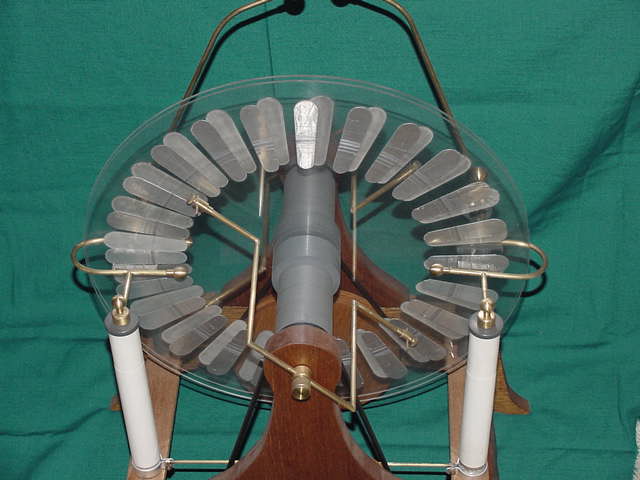
Wimshurst Machine
Many many years ago in my early teens I was
fascinated by static electricity and in particular the WIMSHURST
machine. Over the years I have seen them in museums, in various stages of
disrepair and certainly none of them working. I decided that to see
one in operation the only way was to make one. With the knowledge I had and
gathering information from some handy sites on the net I figured that I had enough to
start.

WIMSHURST MACHINE,
In about 1870 an English scientist name of Wimshurst, invented the device
which consisted of two contra rotating closely spaced insulated discs with
conducting radial segments. There are 4 "brushes" arranged around the
plates two for shorting the segments and two are for collecting the high
voltage. A hand crank powers the machine. Two Leyden jars (high voltage
capacitors) are connected to the high voltage terminals and a spark gap is secured to these points.
OPERATION:
Firstly you electrostatically charge the plates then
by turning the handle the leyden
jars become highly charged. The charge builds up until
the gap breaks down and the jars discharge across the spark gap with quite
an impressive "crack". The machine featured here will spark across about
120mm. This means that many thousands of volts are generated however the current
is so small that only a small shock is felt if discharged onto a finger.
CONSTRUCTION
Discs:
2mm thick clear acrylic 400mmD spaced 3mm apart.
Frame, large pulleys, crank: Timber.
Insulating columns, leyden
jars: PVC rod, Acrylic tube.
Shaft: 9mm brass rod.
Flanges: 25mmD and
60mmD PVC rod.
Belts: "O" rings.
It is quite a hansom machine and is of great interest for visitors and a source of great fun for young and old alike.
Return to home